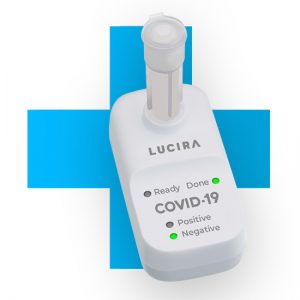7 Things to Know About Lucira, the First At-Home COVID-19 Diagnostic Test to Bag FDA’s EUA
Testing shortages have been a huge problem in the US since the beginning of the pandemic. But the recent surges in cases have put additional stress. In a move to reduce the public burden of disease transmission, the USFDA has granted emergency use authorization (EUA) to Lucira, the first at-home COVID-19 test that suspected patients could perform at the convenience of their home.
“Today’s authorization for a complete at-home test is a significant step toward FDA’s nationwide response to COVID-19. A test that can be fully administered entirely outside of a lab or healthcare setting has always been a major priority for the FDA to address the pandemic,” said Jeff Shuren, M.D., J.D., Director of FDA’s Center for Devices and Radiological Health.
When the pandemic originated, patients had to visit healthcare for testing, which significantly increased the burden on healthcare providers and put them at risk of infection. As time progressed, testing centers started collecting samples at home. This measure helped isolate patients from workers in clinics and diagnostic centers and curbed the spread of infection.
However, the analysis took time, delaying treatment. With the approval of Lucira’s COVID-19 All-In-One Test, patients can test the presence or absence of the infection with accuracy comparable to an FDA-approved test in 30 minutes or less at home. This approval ensures that “more Americans who may have COVID-19 will be able to take immediate action, based on their results, to protect themselves and those around them,” said Jeff Shuren.
How Does One Use the Kit?
Lucira’s at-home test is based on the “swab, stir and detect” design. The test box consists of a test device, sample vial, swab, and simple instructions on using each of the components. Two AA batteries are provided, which are inserted in the test device to turn it on. The user has to use the swab provided and rotate it in the nostril five times to collect the sample. Once it’s done, the swab is stirred in the sample vial and then pressed down in the test device to start the test. The ready light will blink until a positive or negative green light is illuminated within 30 minutes.
How Does the Kit Detect the Virus?
This at-home test is based on RT-LAMP technology that detects the N gene of the SARS-CoV-2 virus. When the light in the device is blinking, the virus’s genetic material (collected from the nasal swab) is being extracted and amplified. The RT-LAMP amplification occurs in two phases, a non-cyclic phase that converts RNA into cDNA and a cyclic phase that amplifies the cDNA. If the virus is present in the sample, the successful amplification of the viral gene creates a pH change and subsequently a color change of the halochromic agents within the reaction mixture. If the virus is absent, no amplification occurs, and the reaction mixture retains its original color. This process takes up to 30 minutes but can yield a positive result within 11 minutes of the test.
 Image Courtesy: Lucira Health
Image Courtesy: Lucira Health
How Sensitive is the Test?
“Lucira’s test is 50 to 60 times more sensitive than antigen tests, and considered the gold standard for determining if someone is infected,” said Lucira health’s CEO Erik Engelson. In a community testing that compared Lucira’s test to an FDA-authorized high sensitivity SARS-CoV-2 test, Lucira achieved a 94% positive percent agreement-the proportion of individuals who tested positive with both FDA authorized test as well as Lucira’s test and 98% negative percent agreement- the proportion of individuals who tested negative on both the tests.
Who Will Be Able to Use the Test?
The Lucira test has been authorized for home use in individuals age 14 and older. The patient’s under the age of 14 could be given the test if a health care provider administers it.
When Will the Tests Be Available for Public Use?
In the beginning, the Lucira tests will be made available to patients served by Sutter Health in Northern California and Cleveland Clinical Florida in Miami-Ft. Lauderdale only. But by early spring in 2021, it will be available nationally through health care providers. Lucira also plans to file a new EUA or make changes to the existing one, according to which patients will be able to communicate with a medical professional online through a dedicated website to arrange a prescription and overnight delivery of the test kit.
Does the Test Require a Doctor’s Prescription?
Yes, indeed! The tests are available only on prescription. The person who wants to get tested should contact their healthcare provider and ask for a prescription for the test. The tests will also be authorized for use in point-of-care settings, for example in doctor’s offices, hospitals, urgent care centers, and emergency rooms.
What Happens if One Tests Positive?
Positive tests are indicative of the presence of the virus. The individuals who test positive should report this to their healthcare providers. According to the EUA, healthcare providers prescribing the test should report all test results from individuals to their relevant public health authorities.
By Ruchi Jhonsa, Ph.D.
Editor: Rajaneesh K. Gopinath, Ph.D.
References
- https://www.fda.gov/news-events/press-announcements/coronavirus-covid-19-update-fda-authorizes-first-covid-19-test-self-testing-home
- https://2nyvwd1bf4ct4f787m3leist-wpengine.netdna-ssl.com/wp-content/uploads/2020/11/FDA-Authorizes-First-Prescription-At-Home-Molecular-Test-for-COVID-19-released-20201118.pdf
- https://2nyvwd1bf4ct4f787m3leist-wpengine.netdna-ssl.com/wp-content/uploads/2020/11/Lucira-Package-Insert-PI.pdf
- https://2nyvwd1bf4ct4f787m3leist-wpengine.netdna-ssl.com/wp-content/uploads/2020/11/Lucira-HCP-Instructions-For-Use-IFU.pdf
©www.geneonline.com All rights reserved. Collaborate with us: service@geneonlineasia.com










